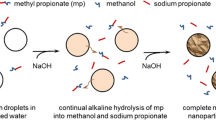Abstract
The nanoparticles of polylactide (PLA) and poly(lactide-co-glycolide) (PLGA) were prepared by the binary organic solvent diffusion method. The yield, particle size and size distribution of these nanoparticles were evaluated. The yield of nanoparticles prepared by this method is over 90%, and the average size of the nanoparticles is between 130–180 nm. In order to clarify the effect of the organic solvent used in the system on nanoparticle yield and size, the cloud points of PLA and PLGA were examined by cloud point titration. The results indicate that the yields of nanoparticles increase with the increase of ethanol in the acetone solution and attain the maximum at the cloud point of ethanol, while the size of nanoparticles decreases with the increase of ethanol in the acetone solution and attains the minimum at the cloud point of ethanol. The optimal composition ratio of binary organic solvents coincides to that near the cloud point and the optimal condition of binary organic solvents can be predicted.
Similar content being viewed by others
References
Soppimath K S, Aminabhavi A R, Kulkarni W E. Biodegradable polymeric nanoparticles as drug delivery devices[J]. J Control Release, 2001, 70: 1–20.
Kevin A J, Marie P F, Ana M, et al. Chitosan nanoparticles as delivery systems for doxorubicin[J]. J Control. Release, 2001, 73: 255–267.
Eliana L, Riccardo C, Flavio F. Dynamic dialysis for the drug release evaluation from doxorubicin-gelatin nanoparticles conjugates[J]. International Journal of Pharmaceutics, 1999, 180: 23–30.
Martine L V, Laurence F, Young K, et al. Preparation and characterization of nanoparticles containing an antihypertensive agent[J]. European Journal of Pharmaceutics and Biopharmaceutics, 1998, 46: 137–143.
Lamprecht A, Ubrich N, Hombreiro perez M, et al. Influences of process parameters on nanoparticle preparation performed by a double emulsion pressure homogenization technique[J]. International Journal of Pharmaceutics, 2000, 196: 177–182.
Lamprecht A, Ubrich N, Hombreiro perez M, et al. Biodegradable monodispersed nanoparticles prepared by pressure homogenization-emulsification[J]. International Journal of Pharmaceutics, 1999, 184: 97–105.
Yoshiaki K, Hiromitsu Y, Hirofumi T, et al. Properties of a peptide containing DL-lactide/glycolide copolymer nanospheres prepared by novel emulsion solvent diffusion methods[J]. European Journal of Pharmaceutics and Biopharmaceutics, 1998, 45: 41–48.
Cristina F, Sergio S, Rogerio G. Paclitaxel loaded PLGA nanoparticles: preparation, physicochemical characterization and in vitro anti-tumoral activity[J]. J Control Release, 2002, 83: 273–286.
Riley T, Govender T, Stolnik S, et al. Colloidal stability and drug incorporation aspects of micellar-like PLA-PEG nanoparticles[J]. Colloids and Surfaces, 1999, 16: 147–159.
Author information
Authors and Affiliations
Corresponding author
Additional information
Foundation item: Project (2001AA218011) supported by the National High Technology Development “863” Program of China
Rights and permissions
About this article
Cite this article
Jiang, Xy., Zhou, Cs. & Tang, Kw. Preparation of PLA and PLGA nanoparticles by binary organic solvent diffusion method. J Cent. South Univ. Technol. 10, 202–206 (2003). https://doi.org/10.1007/s11771-003-0009-7
Received:
Accepted:
Issue Date:
DOI: https://doi.org/10.1007/s11771-003-0009-7




